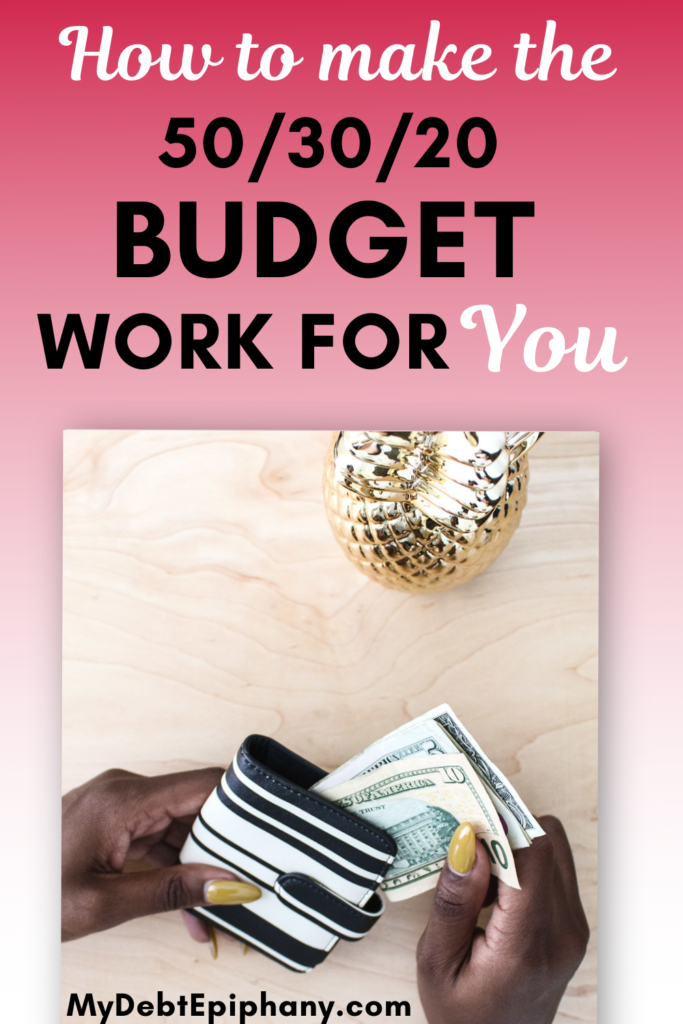The 50-30-20 Budget Plan: What Is It and How Does It Work?
Struggling to come up with your budget and actually stick to it each month? One of the easiest budgeting methods you can start with is the 50 30 20 plan. Also referred to as the 50-30-20 budget, this budgeting style proves that oftentimes less is more when it comes to overcoming the feeling of overwhelm when it comes to your finances.
If you’ve tried to budget before, you probably know it can seem exciting in the beginning. You sit down and track your income then organize all your expenses and set up a solid plan. A feeling of relief sweeps over you as you finally feel like you have some control over your finances and a winning strategy.
Then, life happens.
A rough and busy week leads you to order takeout several nights in a row. You go to Target for one thing but even up getting way more than that. Your child comes how with a book fair flyer and asks for $30 extra.
Before you know it. Your ‘perfect’ budget is crushed and you’re back to square one – feeling pretty down and hopeless about your ability to manage your money and meet goals.
What I love about the 50 30 20 plan for your money is that it allows you to break your spending up into three main categories instead of trying to juggle more than a dozen different expense categories.
Of course, budgeting requires some amount of self-discipline. However, it’s not that difficult and can really lead to you having more control and freedom over your situation. In this post, I want to explain how this budgeting method works in detail and explain the pros and cons of using it as your main budgeting strategy.
Table of Contents
How the 50 30 20 Plan Works
The 50/30/20 budgeting method aims to break down your take-home pay into percentages or categories. Your basic needs make up 50% of the budget, 30% for your basic wants, and 20% for your savings increase and/or debt payments.
The 50-30-20 budget plan gives you a clear idea of how much you should spend in each category. It also motivates you to practice financial discipline. Yes, there are constraints like any budget, but you don’t have to track your purchases to the penny or beat yourself up if your grocery bill exceeds your expectations. Here’s how to get started.
Related: The Ultimate Guide to Budgeting
Determine Your Net Income
Your net income or take-home pay is the money you receive monthly after deduction of taxes. You can also think of it as the money you have to spend and/or save every month.
To determine your monthly net income, you can look at your paycheck or the amount deposited into your account by your employer. For freelancers, entrepreneurs, or independent contractors, determining and budgeting their income can be done using the irregular income method.
Basic Needs (50%)
Since the biggest percentage of your net income goes out to our basic needs, it’s only apt to know what are “basic needs.” Typically, this consists of expenditures, such as your food, rent, mortgage, utilities, insurance, minimum credit card payments, and what-not.
Many people find it challenging to determine their “needs and “wants.” So, allow yourself to ponder on this thought experiment: if you’ll lose your source of income, what are the things you would prioritize or need the most?
For sure, your answers would be your groceries or house or your electricity. Your “want” to buy an expensive pair of jeans or travel to another state will be out of the equation.
Related: How to Come Up With a Bare Bones Budget
Basic Wants (30%)
In this budgeting method, basic wants should be separated from luxurious wants. Examples of the latter are purchasing a new car, having an out-of-state vacation, or getting a pair of designer shoes.
Basic wants are ordinary things you want but you can still live without. Examples are cable, Netflix, your gym membership, or internet subscriptions. You may want these things and having them can make your life more comfortable, but you can be ready to give them up when you’re financially unstable.
Savings and Debt Payoff (20%)
After going through your basic needs (50%) and basic wants (30%), it’s now time to consider your savings and/or debt payoff, which makes up 20% of your 50 30 20 plan.
Building your regular or emergency savings is crucial for your financial health. Plus, what I love about this budgeting method it automatically factors in space for you to make extra debt payments or put money into savings. If you have loans , you and other types of debt, developing a budget is key to help you avoid late payment fees and a negative impact on your credit.
When a 50-30-20 Budget Works
The 50 30 20 plan is a great option for anyone who’s new to budgeting and needs a simplified plan that works. No matter what your expenses or financial goals are, everything will fall into one of the three categories. There’s room in this budget to pay your rent or mortgage, utilities, groceries, make fun purchases and even use a little to pay off debt.
Another thing that I like about this budget is that it helps you learn how to keep your spending lower in certain categories. For example, if you bring home $4,000 per month, you know that you likely can’t afford a $2,000 mortgage because your house payment alone would take up 50% of your income. If you’re spending too much on dining out or expensive hobbies, you’ll need to make cuts where you see fit to keep everything within 30% of your take-home pay.
When a 50-30-20 Budget Might Not Work
A 50-30-20 budget might get tricky if you intend to be very specific with how you spend your money. A complaint that I often hear is that your debt payments may exceed 20% of your income or you may want to save more than 20%. This makes perfect sense. If you want to save more or make bigger debt payments, you should definitely do this.
For many of us though, we learn how to crawl before we can walk. If you’re not saving anything at all, then 10% toward debt and 10% toward savings can sound great. Once you feel like you can do more, you can always adjust the percentages to whatever you see fit. For example, you can switch it to 40% (needs) / 20% (wants) / 40% (savings and debt payoff) if that works better for you.
For me, I have many different types of savings goals and 20% often doesn’t work. Below are just some savings categories that might apply to you and can be worked into your budget:
Savings Account
Setting aside money into a savings account is important because it serves as your source for future financing. If you need to buy a car or a house, you can withdraw money from your savings account for the down payment of your purchase.
Emergency Fund
An emergency fund serves as your cushion when unforeseen events, such as work layoff or illness, happen. Since you will need money in such unfortunate circumstances, your emergency fund will be a big help for you to survive financially.
It’s advisable to set aside 3 or 6 months’ worth of expenses into your emergency fund. You can also save more to ensure that you’ll have enough when emergencies occur.
Related: Why Do You Need a Full Emergency Fund?
Emergency Fund Tips: How to Grow Your Account Fast and Where to Start
Retirement Savings
Saving for your retirement is another crucial strategy to achieve financial stability. For example, you can invest in a ROTH IRA so that you’ll have money to use in your retirement years. This type of retirement savings enables you to invest with your post-tax income.
Related: Have Debt But Want to Invest? Here’s What You Need to Know
Debt Payments
As mentioned previously, it’s essential to pay your loans in time to avoid getting a bad mark on your credit history. So, if you’re currently paying a debt, make sure to include it in your monthly budget.
Pro Tip: If you’re wondering whether the 50 30 20 plan is right for you, go back to the basics and create a line-item budget. I explain how to create a traditional budget step-by-step here.
Then, group all your expenses up into similar categories using the 50-30-20 model. Figure out what your exact percentages are whether they are 53-27-30. That way, you can still make this budgeting method work for you.
Also, you may want to consider creating an annual budget just so you can get a clear picture of your finances and expose any of those sneaky or unexpected expenses that you may not notice occurring month-to-month.
Related: Why and How to Create an Annual Budget
Takeaway
Now you know what a 50-30-20 budgeting method is. This way of budgeting can give you a clear idea about where to spend your take-home pay. This budgeting method helps you categorize your budgeting into basic needs (50%), basic wants (30%), and savings and debt payoff (20%). The 50 30 20 rule won’t work for everyone, but it’s worth considering especially if you are new to budgeting or need clear guidelines to help you organize your expenses.
What are your thoughts on the 50-30-20 budget?
Stop Worrying About Money and Regain Control

Join 5,000+ others to get access to free printables to help you manage your monthly bills, reduce expenses, pay off debt, and more. Receive just two emails per month with exclusive content to help you on your journey.






